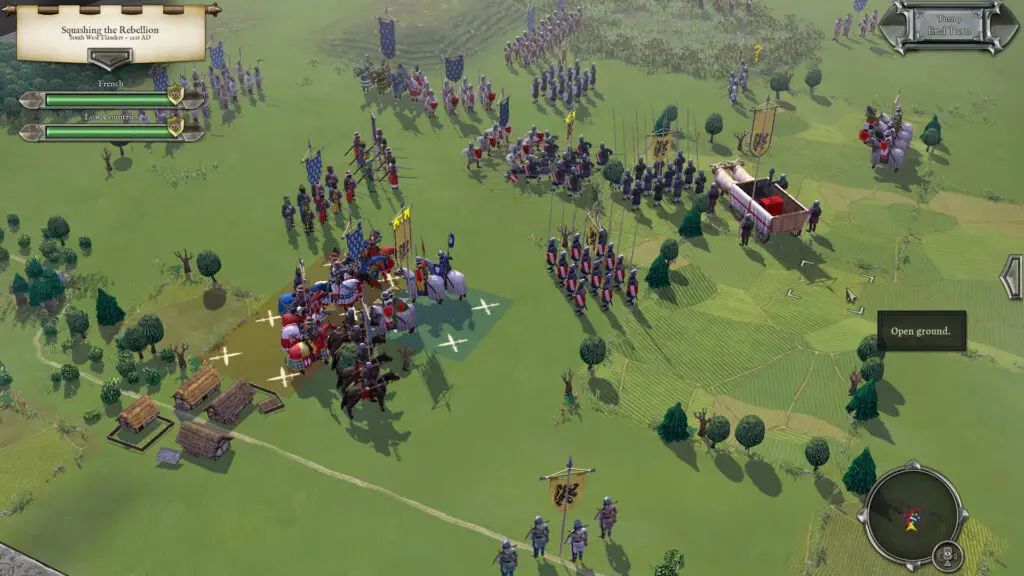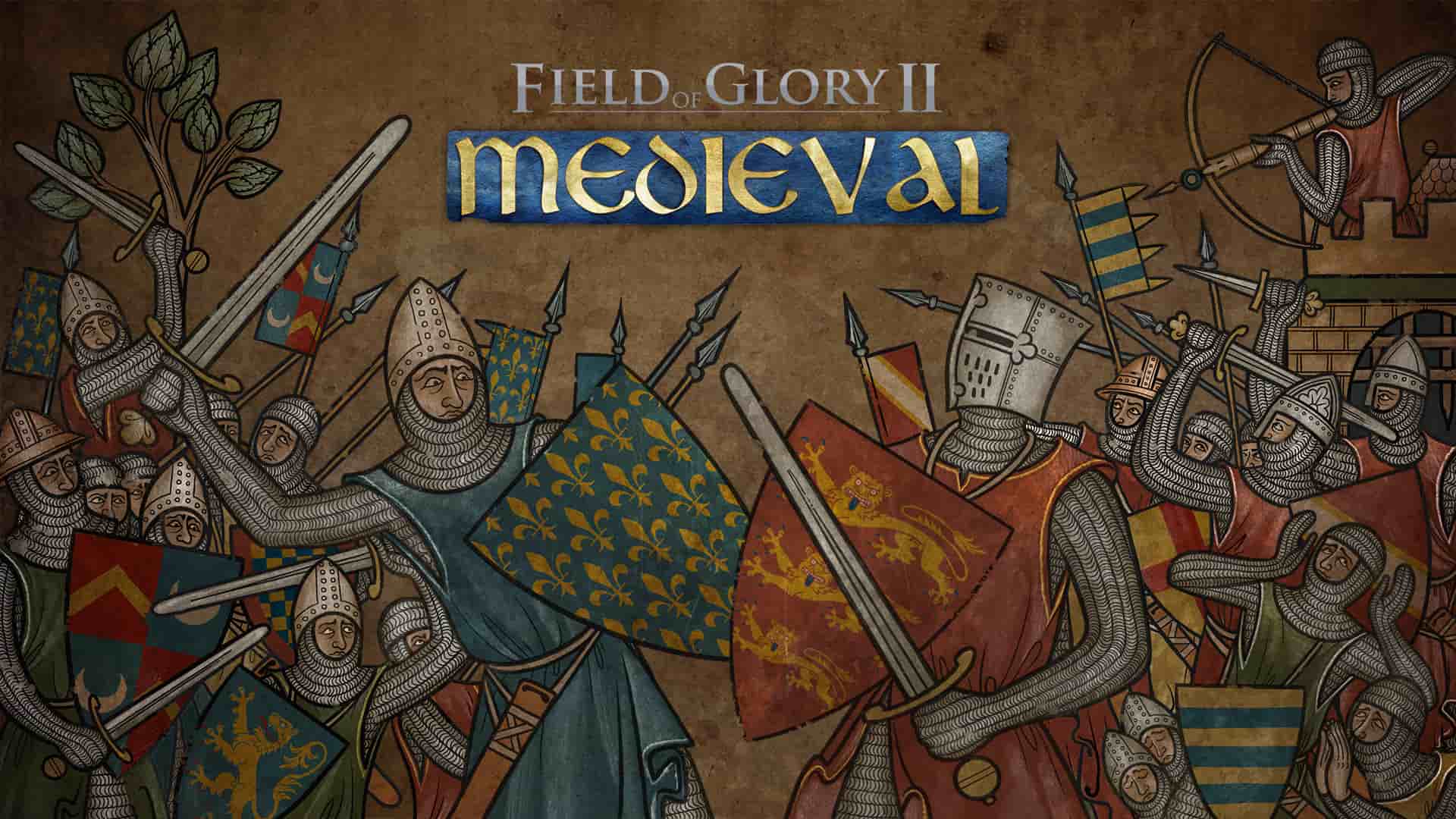Byzantine Games have followed up the excellent Field of Glory 2 with a self-contained DLC/sequel, moving the setting to the early medieval period and away from ancient warfare. The Romans and Greeks are gone but now you can fight the Danes, the English, and Welsh. Whilst you won’t see any sarissa or pilums, you’ll now get a chance to see the great axe and the crossbow.

Field of Glory 2 was an outstanding game that modelled ancient warfare from the time of the Egyptians up to the time of Charlemagne. Using a deep but easy go grasp system, cantering around the concept of the “Points of advantage” which allows the game series to model ranged and melee clashes between different types of troops from many different worlds.
Field of Glory II: Medieval (hereafter abbreviated to FOG:M) moves the series on a couple of hundred years, offering up a whole new set of armies, set-piece battles, campaigns, and opportunities to step outside of history and fight some what-if battles.
The battlefield is rendered in presentable and easy to understand 3d terrain, ranging from terrain types like mountain, tundra, and desert all the way to your run of the mill plains. Armies deploy on either side of the field, with skirmisher and scout units able to deploy ahead of the rest of the army. This is one of the tell-tale signs that FOG:M is an adaption of a much-revered miniatures game system and this comes through elsewhere too. Zoom in to the troop units and you’ll see your soldiers lining up, sometimes with alternating colour schemes. There’s a lot of variation and exotic unit types can stand out amidst the more prosaic spearmen and archers.
Armies then march towards their opponents in an I-Go You-Go turn-based mode. The game uses a simple and easy to understand system of orders. Many units in the game are slow and cannot easily manoeuvre and so you’ll need to plot your moves in advance as they cannot turn easily. The armoured knights are the main battle tanks of this world but they do not steer well and struggle to change facing quickly.
Missile units and skirmishers are able to launch volleys, thinning out enemy units’ numbers and, more critically, reducing their cohesion making them easier to break. The game stresses that its far more effective to break an enemy army’s spirit than kill all its men. As units take damage or suffer some other setback, they can become disordered, fragmented, and, eventually, broken. As units break, they’ll flee and only a very effective general near them will be able to rally them before they flee the battlefield. Lose too much of your army and you lose the battle.
Much of the standard tricks and tools of the battlefield are present here, with units fighting better with higher elevation and when they can strike the flank or rear of an enemy unit. The inventive points of advantage system also model things like weapon types, training, and other characteristics and you’ll find that you may take a while to master what each unit can do and who it fights well against. Whilst there are some generic units, like the ubiquitous light archers or light cavalry, most other units are specific to their army list. A player can always click on any unit and open up a list of their potential abilities and the POA that would stem from them.
Once units get close, then it’ll be a charge and a melee as each unit takes turns whacking the other one, with little numbers floating away telling you how many casualties the unit suffered and red numbers are bad news, meaning that you’re side has taken a beating in that exchange! You’ll also see the occasional status change such as disordered, pushed back or the dread general fallen.
So far so good but how does the game differ from the original? There’s certainly a number of nice UI improvements and the graphics are cleaner and more approachable. The unit graphics and maps are more or less as they were but they didn’t need any improving and the units still look great. Some players get a bit annoyed by the strange scale where buildings are small but the soldiers tower over them like giants but that’s just an abstraction as your typical unit is a few hundred men but only ten or fifteen are modelled on screen.

The other changes include a new set of armies, battles, and campaigns, with the invasion of Saxon England by the Normans and the rather interesting northern crusade available as campaigns. These are tough campaigns, offering you a set of choices between battles, to see units gain experience, and to leave garrisons behind. This isn’t a fully-fledged empire building game, though Field of Glory 2 was supported by the brilliant Field of Glory: Empires and perhaps one day FOG:M will be by its own sister game. But for now, the campaigns are just linked battles with the odd interesting decision to determine what reinforcements you gain and what units you leave behind as garrison forces.
There’s also the option to fight a “sandbox” campaign which will see you choose your army and your opponent(s) and then the game will generate battles, linked by a narrative for you to fight out as you wish. All battles generated by the excellent game system can be historically plausible or you can just throw two random armies against each other to see what happens.
One of the main changes between the two games is the way the games play out and the composition of the armies. Skirmishers are less prominent in these battles as thick lines of infantry and cavalry will do much of the slaughtering. With most units unable to “turn” for free, you’ll also find that your initial deployment becomes more crucial than ever.
The AI, already good in the old game, is even better here and will offer a stiff challenge and you may take a few battles before you get the underlying strategy. And that strategy can’t be used in every battle against every opponent, there’s no simple way to win every battle which gives the game a deep well of challenge. The game is also well supported by a suite of multi-player options and there’s a good pool of players for the original game.
With the use of points values and army lists, there’s also scope for matched play, and competitive games of FOG:M could be a big hit. You can also tick a box to fight a battle in hotseat mode if you have someone in your house with you over lockdown you want to lock horns with, or if you just wanted to try out some units playing both sides.
Finally, there’s a strong suite of “epic battles” which are historical battles modelled with large armies and pre-designed battlefields. You can refight Hastings here and see just how hard the Saxons were to dislodge from Senlac Hill! The game is also very well supported by an excellent map editor and if the previous iterations are any indication, then there will likely be a decent amount of fairly priced DLC to support this release down the road.

Which brings up the main thorny issue with this release; why not just make it a DLC? The game is different to the base game but is it different enough to justify being its own stand-alone release? In balance, perhaps not but there’s a positive here too which is if ancient warfare isn’t really your bag, then you needn’t buy a game you didn’t want to play this one.
There are some minor quibbles. The game’s sound design is utilitarian and often I’ll put some music on whilst playing it as the tinny weapon and horse effects get old quite quickly. The current game largely focuses on the northern European countries which may mean that some players are missing out on armies and battles they’d prefer to fight. There’s also the niggle when fighting armies with lots of horse-archers or other light cavalry as they’ll constantly attempt to evade away from your troops which can be annoying but this is a feature, rather than a bug. Its that sort of warfare that will string an enemy’s lines out and cause them to break up a formation.
FOG:M is a great game, following in the footsteps of an all-time classic. Battles can be very tense and momentum can switch suddenly. The death of a general can cause a shockwave of panic in an army. You may break the enemies right with a well-placed cavalry charge but can you hold the centre whilst they roll up your flanks? Strong, disciplined, and well-armed units will outperform their opponents but they’re not invincible and even elite knights can be swarmed by hundreds of lesser opponents, suffering an ignominious death. All in all, FOG:M is probably a must-have purchase for anyone who’s a fan of the original. For those who like turn-based wargames and the medieval period, this is also well worth picking up. FOG:M offers a fairly easy game to learn but a tough game to master and with a huge, rich array of armies and battles, you can be rest assured that you’ll be returning over and over, with some new gambit to try and a vendetta to settle!









